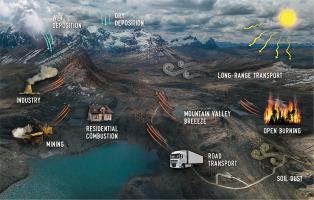Global and Planetary Change ( IF 4.0 ) Pub Date : 2022-05-05 , DOI: 10.1016/j.gloplacha.2022.103837 S. Gilardoni 1 , B. Di Mauro 1 , P. Bonasoni 2

|
Tropical glaciers are extremely sensitive to changes of climate variables. Their response to climate change is complex and depends on multiple mechanisms affecting their mass and energy balance, including deposition of light absorbing particles (LAPs) from the atmosphere on snow and ice. Such particles can reduce glaciers surface albedo, thus enhancing the melting process. LAPs include carbonaceous particles (black carbon - BC and organic carbon - OC) and mineral dust aerosol (MDA). Although their relevance in global cryosphere, LAPs observations in the Andes tropical glacier areas are limited and sparse. This review aims at providing a critical evaluation of available data on LAPs in South America tropical glaciers, and highlights research gaps that will help to improve our understanding of natural processes and anthropogenic emissions impacts on the cryosphere of the region.
In South American tropical glaciers, LAPs measurements in surface snow are mainly focused in the Cordillera Blanca and limited information are available about their chemical composition (carbonaceous or mineral components), while dust ice core records have been investigated in several sectors of the Andes, including in the Cordillera Blanca, Cordillera Oriental, and Cordillera Real. Remote and field observations in South American tropical glaciers indicate that LAPs might explain a significant fraction of snow albedo variability, however snow albedo reduction from modelling studies varies significantly depending on LAPs concentration and composition. Carbonaceous LAPs sources in South America are dominated by BC emissions from open fires, linked to agricultural and land clearing activities, peaking in the southern hemisphere dry season (August–October). Natural and anthropogenic dust emissions are potentially relevant contributors of LAPs on the Andes glaciers, as well. Satellite and in-situ measurements were deployed to investigate transport episodes of carbonaceous and mineral particles from lower altitudes towards the Andean glaciers. Nevertheless, the small number of atmospheric records of BC, OC, and MDA does not allow a systematic understanding of transport and deposition processes of such species in the region.
中文翻译:

南美热带冰川中的黑碳、有机碳和矿物尘埃:综述
热带冰川对气候变量的变化极为敏感。它们对气候变化的反应是复杂的,取决于影响其质量和能量平衡的多种机制,包括从大气中的光吸收粒子 (LAP) 在冰雪上的沉积。这种颗粒可以降低冰川表面的反照率,从而增强融化过程。LAP 包括碳质颗粒(黑碳 - BC 和有机碳 - OC)和矿物粉尘气溶胶 (MDA)。尽管它们与全球冰冻圈相关,但在安第斯热带冰川地区的 LAPs 观测是有限且稀疏的。本综述旨在对南美热带冰川 LAP 的可用数据进行批判性评估,
在南美热带冰川中,表层积雪中的 LAP 测量主要集中在布兰卡山脉,关于其化学成分(碳质或矿物成分)的信息有限,而安第斯山脉的几个部分已经研究了尘埃冰芯记录,包括在科迪勒拉布兰卡、科迪勒拉东方和科迪勒拉真实。南美热带冰川的远程和实地观测表明,LAP 可能解释了雪反照率变化的很大一部分,但是建模研究中的降雪反照率因 LAP 浓度和成分而异。南美洲的碳质 LAP 来源主要是明火产生的 BC 排放,与农业和土地清理活动有关,在南半球旱季(8 月至 10 月)达到高峰。自然和人为的粉尘排放也是安第斯冰川上 LAP 的潜在相关贡献者。部署了卫星和原位测量来调查碳质和矿物颗粒从低海拔地区向安第斯冰川的运输事件。然而,BC、OC 和 MDA 的少量大气记录无法系统地了解该地区此类物种的迁移和沉积过程。











































 京公网安备 11010802027423号
京公网安备 11010802027423号